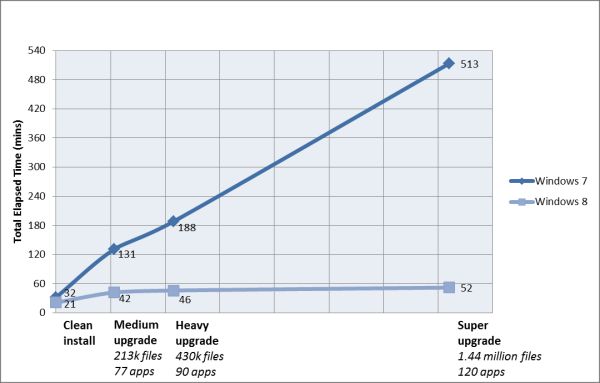Windows 8 to Feature Streamlined Downloadable Installer
by Andrew Cunningham on November 22, 2011 11:00 AM ESTAs with every new Windows version, Microsoft is streamlining the Windows setup process, writes Christa St. Pierre on the Building Windows 8 Blog. The biggest change is the new online installer for Windows 8, which can download the installation media directly from Microsoft's servers and install the operating system without so much as bothering the user for a product key (for upgrade installs). Those wanting to do clean or advanced installs will be given the option to copy the installation files to a DVD or USB drive.
Windows 8 will further streamline the upgrade process by folding both Windows Upgrade Advisor, which scans your computer for hardware and software and checks its compatibility with Windows 8, and Windows Easy Transfer, which allows easy and granular controls for backing up and restoring files and settings, into the Windows installer rather than keeping them as separate applications. The new installer will be able to upgrade OSes as old as Windows XP (which will preserve only user data), though users upgrading from Windows Vista or Windows 7 will also be given the option to preserve Windows settings and applications, respectively.
Lastly, Microsoft has made changes to how the upgrade install works with user files to reduce the amount of time taken. Previous installers would move user files to a temporary location, install the OS, and then move them back. The Windows 8 installer reduces the number of file moves, and uses "hard links" to files to change their location in the file structure without physically moving the data around. Microsoft's graph below shows a drastic reduction in time for an upgrade install under Windows 8.
For those of you who prefer boxed software, Microsoft will continue to sell boxed copies of Windows on DVD. Users who initiate the install by booting from a DVD or USB drive will continue to see more advanced options for performing clean installs and partitioning disks. Enterprise administrators and power users who need more customization options can continue to use Microsoft suite of deployment tools (now called the Windows Assessment and Deployment Kit, or ADK).
For more details, check out the post at the Building Windows 8 Blog.
Source: Building Windows 8 Blog











28 Comments
View All Comments
FATCamaro - Tuesday, November 22, 2011 - link
First the app store, then touch everything, then ultrabooks, now downloadable installer.azmodean - Tuesday, November 22, 2011 - link
Yea, because Apple invented all of those things, oh wait, make that none of them.B3an - Tuesday, November 22, 2011 - link
And it's only a matter of time before Apple copy MS again with Windows 8. They're almost definitely going to merge iOS and OSX together at some point. Where as MS will already have a single OS that runs on everything.I'd also bet that Apple ripoff Windows 8 features with small updates to OSX before Win 8 ships. They always do this when MS show Windows feature so far before release, then everyone thinks MS are copying Apple when it was MS who did it first.
solipsism - Tuesday, November 22, 2011 - link
"Where as MS will already have a single OS that runs on everything."No they don't. not even close. They'll have Windows 8 for "PCs" and tablets, WP7 for smartphones, and whatever bastardized version for their game console.
Apple has OS X for every HW product, sans some iPods: Macs, AppleTV, iPod Touch/iPhone, and iPad. The last three running a streamlined version of OS X called iOS, and the last two running the same UI foundation, CocoaTouch.
Targon - Tuesday, November 22, 2011 - link
And what makes you think that Windows 8 won't be made to run on a phone when Metro is CLEARLY designed with tablets in mind? Microsoft has been doing consolidation of multiple product development lines for quite a while now. Remember Windows 98/ME was consumer, with Windows NT/2000 on the corporate side, both lines merged into Windows XP. WP7 is now on phones, and Windows 7 is on PCs, so it makes sense that Windows 8 would end up merging both the ultra-mobile and desktop/laptop designs going forward.solipsism - Tuesday, November 22, 2011 - link
I'd love to see Windows become more unified but it looks like it'll be at least another 5 years before that could happen.I'm not too thrilled with what I've seen of W8/Metro for tablets, but I love my experience with WP7. I hope they can get a foothold in the market sooner rather than later.
ananduser - Wednesday, November 23, 2011 - link
Oh come on, how can *you* be thrilled with Windows(8,9,7 or any version)? We both know that Win8 by the looks of it will be a catastrophic fail. Nothing can stand the mobile onslaught of Ios and Android; Linux and OSX on the desktop front.JKflipflop98 - Thursday, November 24, 2011 - link
Dude, you're delusional if you think Linux is anywhere near ready for the desktop. Windows destroys it in every metric possible.Fritzr - Wednesday, November 30, 2011 - link
He's not delusional he has also noticed that OSX is shoving Microsoft off of the desktop :Pinighthawki - Tuesday, November 22, 2011 - link
I think it's pretty clear that the goal is for windows 8, or a version thereof, to run on all devices, including desktops, laptops, tablets, phones, and the xbox. Whether or not those devices will have a "slimmed down" version of the OS is another story, but ultimately having a single OS that can do everything is a goldmine.